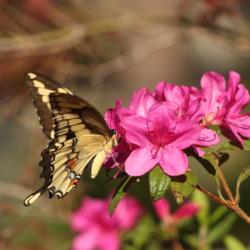


Everyone loves to watch butterflies flit around. Large or small, ages 1 to 99, butterflies painted with diverse colors and patterns are a welcome sight. You can increase your butterfly viewing opportunities by creating spaces more attractive to them.
Butterfly Garden Planning
Start with a location that gets at least 6 hours of sun. Butterflies need the sun's warmth and most plants that attract butterflies grow best in full sun.
Determine how much space you have and any items other than plants that you'd like to include. Consider adding a large flat rock or two. Butterflies love to bask on them, often with their wings spread out to catch more sun. Also allow room for a tray or a pot saucer filled with moist sand as a water source to encourage butterflies to linger longer.
Now plot out how much room you'll have for plants. When selecting plants, keep in mind the needs of both the caterpillar and the adult stages of the butterflies you hope to attract. While many adult butterflies enjoy the nectar from a wide range of flowers, the caterpillars of some species feed on a more limited variety. For example, while adult monarch butterflies enjoy nectar from many different kinds of flowers, the caterpillars will feed only on milkweed plants. Also, be sure to choose nectar-providing plants with a variety of bloom times so that there will be flowers in the garden throughout the growing season. Choose some that bloom in early spring, some in later spring; add others for summer and fall flowers. Check the space each plant will take to ensure you'll have enough room for your favorites.
Helping Monarchs
As we mentioned, caterpillars of the monarch butterfly feed only on milkweed plants (Asclepias spp.), so be sure to include some to support the monarch's entire life cycle. If possible, select at least two different milkweed species that grow in your area. In the Northeastern U.S. choose from common milkweed (A. syriaca), swamp milkweed (A. incarnata), butterfly weed (A. tuberosa), whorled milkweed (A. verticillata) and poke milkweed (A. exaltata). In the Southeast choose from butterfly weed, whorled milkweed, white milkweed (A. variegata), aquatic milkweed (A. perennis) and sandhill/pinewoods milkweed (A. humistrata). In the south-central region green antelope horn milkweed (A. viridis), antelope horn milkweed (A. asperula) and zizotes milkweed (A. oenotheroides) are possibilities. In the West (except for Arizona and California) consider Mexican whorled milkweed (A. fascicularis) and showy milkweed (A. speciosa). Those in Arizona can choose among butterfly weed, antelope horn milkweed, rush milkweed (A. subulata) and Arizona milkweed (A. angustifolia). Californians can choose from Mexican whorled milkweed, showy milkweed, desert milkweed (A. erosa), California milkweed (A. californica), heartleaf milkweed (A. cordifolia), wooly milkweed (A. vestita) and wooly pod milkweed (A. eriocarpa).
Nectar through the Seasons
Spring flowering trees and shrubs that provide nectar early in the season include serviceberry (Amelanchier spp.), redbud (Cercis canadensis), flowering dogwood (Cornus florida), spicebush (Lindera benzoin), and pussy willow (Salix discolor). Some mid-season shrubs include leadplant (Amorpha canescans), buttonbush (Cephalanthus occidentalis), and summersweet (Clethra alnifolia). Butterfly bush (Buddleia spp.) has long been a popular butterfly-attracting plant, but it has become an invasive problem in many areas of the country. If you'd like to include this plant in your garden choose one of the new sterile (don't produce viable seeds) butterfly bush hybrids such as cultivars 'Miss Molly' and 'Miss Ruby', and varieties in both the Flutterby and Lo & Behold series.
The list of herbaceous nectar plants is very lengthy and varies with the regions of the country. Talk to your favorite local garden center or native plant supplier for recommendations. Some of my favorites include columbine (Aquilegia spp.), wild blue phlox (Phlox divaricata), coreopsis (Coreopsis lanceolata, C. tripteris, and other species), bergamot (Monarda fistulosa), black-eyed Susan (Rudbeckia hirta), false aster (Boltonia asteroides), stiff goldenrod (Solidago rigida) and almost any of the asters (Symphyotrichum spp.).
Once a butterfly garden is established little maintenance is usually required. If you do any trimming of milkweed in late June or early July be sure to check for monarch eggs or larvae and move them to plants in untrimmed areas.
With proper planning, good plant selection and minimal maintenance you can create an area that will not only attract butterflies but will help to preserve these important and beautiful insects that are so vital to our ecosystem.
Steve Trusty has a degree in horticulture from Iowa State University. He has been helping gardeners receive more enjoyment from their lawns and gardens for years through radio, TV, books, magazines and websites.